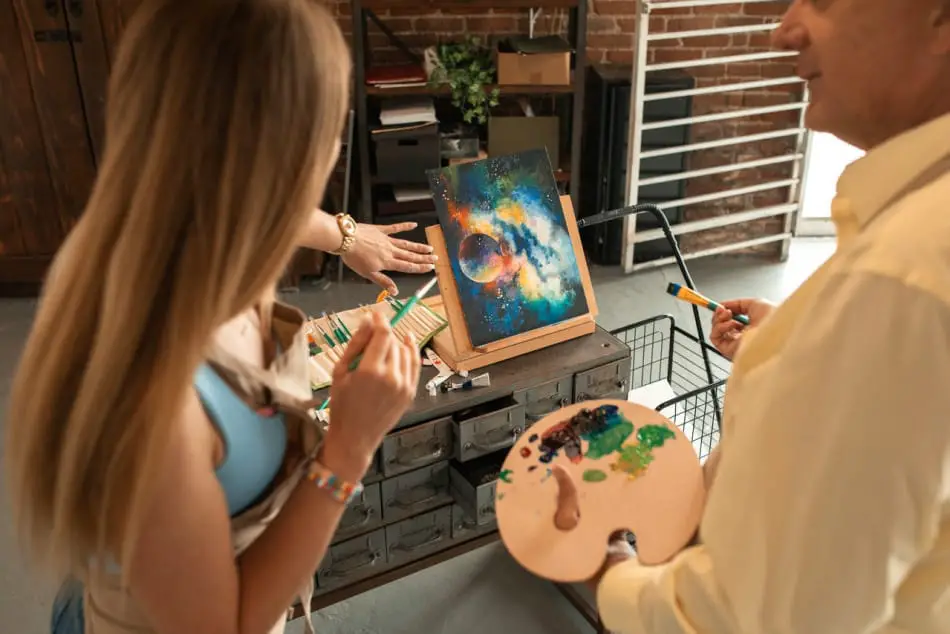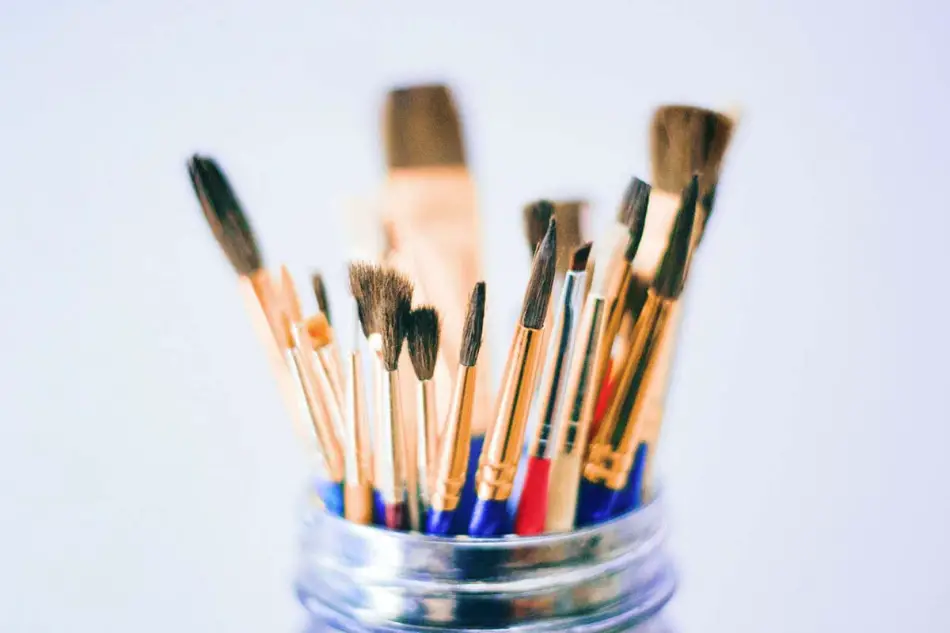To put imagination and creativity onto the white pages with painting has been a long-held desire for people of all ages and professions.
Many people give up on this desire due to the assumption that painting is costly, needs too many resources, or requires innate talent. It is a simple, and creative process that anyone can choose to begin with any day.
Acrylic painting is great for beginners, read on to learn more!
Yes, you can learn acrylic painting by yourself as it does not require any special amenities, nor does it need you to follow any complex steps. Acrylic painting is easier to learn than watercolor or oil painting, as you can fix any mistakes by simply adding another layer of paint!
It becomes easy to avoid complexities while learning acrylic painting if you know the right techniques to proceed with.
Once you get to know the pitfalls to avoid, learning acrylic painting will become easier than ever.
Today, you’ll gain insight into why acrylic painting is so easy to learn by yourself and how to start with.
So, let’s start.
How To Learn Acrylic Painting By Yourself?
To learn acrylic painting all by yourself, follow these below-mentioned steps:
-> Read Also What Is An Autodidact?
Step 1: Set Up The Painting Station

First, pick a tranquil corner of the house and set up your supplies. For instance, you can:
- Position the canvas on the easel stand
- Keep the acrylic brushes in a durable cup beside the palette
- Place the paper towel or rag near the palette
Position the supplies in orientation to the hand you will use to hold the brush and paint. Also, cover the room floor with a tarp or rug.
Step 2: Try Experimenting & Practicing with the Supplies
To learn acrylic painting, you will first have to be familiar with its media. You’ll have to understand how to apply the paint, how it sets on the canvas, how rapidly it dries, and how acrylic paint blends with other colors.
Some doable ideas for ways to experiment and practice with acrylic paints involve the following:
- Colorway all the acrylic paint colors into the canvas to determine how fast it dries up, how the colors apply to the canvas, and their opacity level.
- While doing this, use water to see how it affects the opacity and consistency of the acrylic paints.
- Make a linear gradient to see how the paints blend with one another. Try it out with black to white or red to blue.
These experiments and practices will help you boost your confidence to move forward and progress in learning.
Step 3: Conceptualize & Create a Rough Sketch
Before you begin using a brush on paper, it’s crucial to conceptualize the painting.
It’s simple: you’ll have to think and decide what you want to create for your acrylic painting.
Use a light pencil or charcoal to sketch the painting you want to make. Conceptualizing your painting is crucial to learn before proceeding with your acrylic painting.
You can also take some inspiration from some of the popular Youtube videos. Here you will get an idea of how acrylic painting concepts work.
Step 4: Begin Painting
You’re all set to begin with your first acrylic painting. With all the insights above, it should now be easier for you to paint.
However, if you still feel nervous or reluctant, it’s advisable to use only a couple of colors. Once confident, you can use whatever color you want.
While practicing acrylic painting, you must be aware of some general rules:
- Always level up from light/mid-tone colors to dark-toned colors.
- Remember to start with large shapes, followed by small detailings.
- Keep in mind that acrylic paints tend to dry a lot quicker than other paint mediums.
Step 5: Learn To Preserve
Preserving your piece of art is also a part of learning acrylic painting. As acrylic paints dry quickly and are water-resistant, they tend to preserve themselves pretty well.
However, if you want the acrylic paint to last for an extended period, use acrylic-approved varnish on the painting.
You can easily get it from online stores like Amazon. They ensure a glossy and clean appeal to your painting and protect it from paint-flaking and scratches.
Why Is Acrylic Painting Considered Easier Than Oil or Watercolor Painting?

When it comes to learning about painting, acrylic stands out as one of the most forgiving painting mediums. And the reasons for that include:
- Learning acrylic painting is budget-friendly and easy, to begin with.
- Supplies needed for acrylic paints are readily available on the market.
- Compared to oils, acrylics are much simpler to use.
- Palettes and brushes are easier to clean in acrylic painting.
- You can easily correct your mistakes in an acrylic painting.
- As a beginner, you’ll get satisfying results with minimal techniques much more quickly than any other painting medium.
- Also, acrylics are much more flexible to use.
Some painting mediums like oil and canvas tend to be challenging to learn due to their inconvenience.
They either consume excess space, become difficult to get to, or require a special location.
However, you can paint anywhere with acrylics, like your kitchen or dining table.
If you stick to the basics, you won’t have to worry that much about the initial outlay.
The reason that you can learn acrylic painting all by yourself is that they are convenient.
They take minimal drying time and do not smell like oil paintings. It also enables you to clean the brushes easily.
Thus, it becomes an ideal choice to learn acrylic painting, especially if you live in an open plan or small property where other painting mediums can emit fumes.
You won’t need any special cleaners for your acrylic brushes and palettes. Simply use water and soap, and the work is done.
You can easily store these paintings as they dry up faster. They won’t require any harsh chemicals, but you can always choose to use additives.
Even if you make a mistake, you can correct it with another layer of paint over the quickly dried-up mistaken part.
You can learn a few simple techniques to achieve great results from your acrylic painting.
-> Learn More about Self-Learning vs. Classroom Learning: Which Is Better?
Supplies That Make Learning Acrylic Painting Easier

The fundamental things you need for acrylic painting are a palette, brushes that are approved for acrylic paint, a rag, a canvas, and soap and water for cleaning.
Also, an easel can come in handy in supplies. Like any other supplies, you’ll find differences in the quality of materials here too.
Considering you are a beginner, you should go with “student-grade” or low-cost supplies.
When you start to gain confidence with your acrylic painting skills, you can switch to expensive or high-quality products.
To summarize, you can check the list of all the supplies you’ll need to learn acrylic painting and a table describing it in detail.
The supplies needed to learn acrylic painting are:
- Acrylic paints
- Acrylic paint brushes
- acrylic paint round brush
- acrylic paint angled brush
- acrylic paint fan brush
- acrylic paint flat brush
- acrylic paint wash brush
- acrylic paint liner brush
- Canvas and Easel (go with the acrylic approved boards)
| Supplies | Examples | Price (subject to change) | Feature |
| Acrylic paints | Caliart Acrylic Paint Set | $25-$30 | High Quality, Rich Pigments, Certified, Safe & Non-Toxic |
| Acrylic paint brushes | BOSOBO Paint Brushes Set | $8-$13 | High-quality craftsmanship, easy maintenance |
| Canvas | VARIETY CANVAS Cotton Canvas Board for Acrylic Painting | $300 | Lightweight, durable, 100% cotton |
| Easel | Comgrow Anti-Slip Sturdy Acrylic Easel Plate Display Stands | $15.99 | Foldable convenient design and extra anti-slip silicone dots |
Frequently Asked Questions
1. What is the longevity of an acrylic painting?
The shelf life of an acrylic painting is around ten years or more on average, provided it’s stored properly. The painting can be used if it remains unopened for ten years.
2. What’s a good beginner painting?
Undoubtedly, an ideal painting type for beginners would be something that’s easy to work with and easier to correct.
When beginners begin to paint, they should choose something with lesser details and smooth tones.
3. Why is acrylic so popular among beginners?
Acrylic paint is trendy among beginners as they are water-soluble, forgiving in nature, ensures quick-drying, and is relatively inexpensive.
4. How can I make an oil acrylic painting?
To experiment with oil acrylic painting, you’ll have to blend the paint with black or white color.
Mixing it with white color will lighten the tone, whereas mixing it with black will darken it.
In both cases, you’ll get a visually-appealing oil painting effect on the canvas.
-> Learn more about 7 best websites for self-learning
Final Thoughts
Hopefully, with our guide, you now know the supplies, steps, and tips for learning acrylic painting by yourself.
Everyone is creative in their own way, and everyone can paint. It’s just a matter of time and practice to perfect your skills.
So, start practicing acrylic painting, and one day you’ll master it.
Until then, happy painting!






